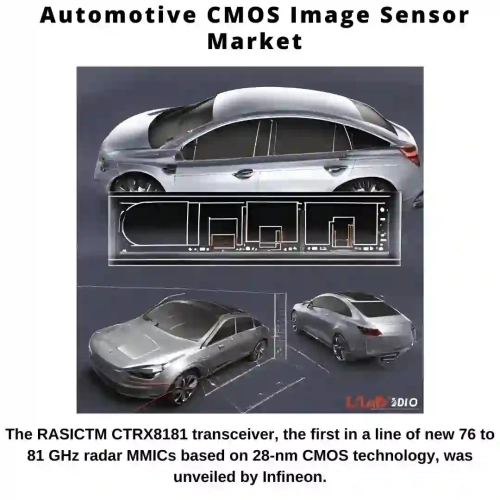
- Get in Touch with Us

Last Updated: Apr 25, 2025 | Study Period: 2024-2030
A form of image sensor technology created especially for use in automobile applications is known as an automobile CMOS Image Sensor (Complementary Metal-Oxide-Semiconductor). It plays a crucial role in automobile camera systems that are utilized for a variety of functions, such as driver assistance, safety features, and autonomous driving.
In order to capture visual data, CMOS image sensors are typically found in digital cameras, cellphones, and numerous other gadgets. In the automobile industry, CMOS image sensors are built into cameras that are positioned all around the car to give the driver a real-time view of their surroundings.
These sensors transform light into electrical signals that are processed by onboard computer systems to help with a variety of activities, including object detection, lane departure warning, pedestrian recognition, and more. An automotive CMOS image sensor operates as follows:
Photons (light particles) can be captured by the sensor's array of tiny, light-sensitive pixels when they are exposed to the scene being seen. Signal conversion: When photons strike pixels, electrical charges are created. The circuitry of the CMOS sensor subsequently transforms these charges into voltage signals. Signal Amplification and Readout: The voltage signals from the individual pixels are amplified and read out. Depending on the architecture of the sensor, this readout procedure can take place either row by row or column by column.
The analog voltage signals are then transformed into digital signals so that the computer systems in the car can process them.Digital picture data is processed in a number of ways, such as noise reduction, color correction, and enhancement.

The Global Automotive CMOS Image Sensor Market accounted for $XX Billion in 2023 and is anticipated to reach $XX Billion by 2030, registering a CAGR of XX% from 2024 to 2030.
The RASICTM CTRX8181 transceiver, the first in a line of new 76 to 81 GHz radar MMICs based on 28-nm CMOS technology, was unveiled by Infineon. High system-level performance and robustness are provided by the transceiver's linearity and increased signal-to-noise ratio.
Additionally, the user-friendly radar transceiver provides flexibility for new software-defined vehicle architectures as well as a scalable platform approach for various sensors, including corner, front, and short range. This makes it possible to create 77 GHz car radar applications more affordably.
The new CTRX8181 transceiver offers accurate object separation and detection required for protecting vulnerable road users such as motorcycle riders, cyclists, or pedestrians. The effective implementation of reliable aided and automated driving features for all SAE levels, up to Level 4, depends on the enhanced RF performance.

| Sl no | Topic |
| 1 | Market Segmentation |
| 2 | Scope of the report |
| 3 | Abbreviations |
| 4 | Research Methodology |
| 5 | Executive Summary |
| 6 | Introduction |
| 7 | Insights from Industry stakeholders |
| 8 | Cost breakdown of Product by sub-components and average profit margin |
| 9 | Disruptive innovation in the Industry |
| 10 | Technology trends in the Industry |
| 11 | Consumer trends in the industry |
| 12 | Recent Production Milestones |
| 13 | Component Manufacturing in US, EU and China |
| 14 | COVID-19 impact on overall market |
| 15 | COVID-19 impact on Production of components |
| 16 | COVID-19 impact on Point of sale |
| 17 | Market Segmentation, Dynamics and Forecast by Geography, 2024-2030 |
| 18 | Market Segmentation, Dynamics and Forecast by Product Type, 2024-2030 |
| 19 | Market Segmentation, Dynamics and Forecast by Application, 2024-2030 |
| 20 | Market Segmentation, Dynamics and Forecast by End use, 2024-2030 |
| 21 | Product installation rate by OEM, 2023 |
| 22 | Incline/Decline in Average B-2-B selling price in past 5 years |
| 23 | Competition from substitute products |
| 24 | Gross margin and average profitability of suppliers |
| 25 | New product development in past 12 months |
| 26 | M&A in past 12 months |
| 27 | Growth strategy of leading players |
| 28 | Market share of vendors, 2023 |
| 29 | Company Profiles |
| 30 | Unmet needs and opportunity for new suppliers |
| 31 | Conclusion |
| 32 | Appendix |